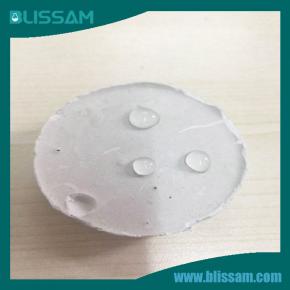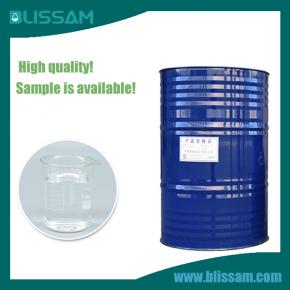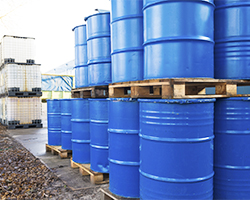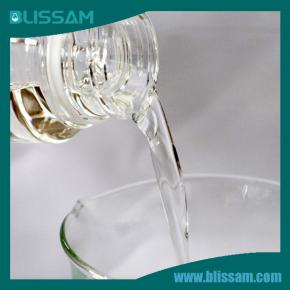BLISSAM product line includes silicone fluids for medical and pharmaceutical purposes, as well as for industrial and consumer use. Our medical-grade silicone fluids are specially designed for use in medical devices, drug delivery systems, and surgical coatings. They are safe, non-toxic, and biocompatible, making them ideal for medical applications. In the industrial sector, our silicone fluids are used in a variety of applications such as lubricants, hydraulic fluids, and heat transfer fluids. They provide excellent thermal stability, chemical resistance, and low volatility, making them an ideal choice for harsh operating environments. Additionally, our consumer-grade silicone fluids can be found in household products such as shampoos, conditioners, and cosmetics, providing users with silky smooth and glossy results.
One of our most popular products is our silicone oil, which serves as an excellent lubricant for machinery and equipment. It has a high thermal stability and a wide operating temperature range, making it ideal for use in extreme conditions. Our silicone oil is also commonly used in the automotive industry, where it helps reduce engine wear and improve fuel efficiency. At Silicone Fluids, we are dedicated to providing our customers with the best silicone solutions. We have a team of experienced professionals who are committed to quality and continuously work towards improving our products and services. With our state-of-the-art manufacturing facilities and stringent quality control standards, we can ensure that our silicone fluids meet the highest industry standards.
In addition to our diverse range of products, we also offer custom formulations and packaging options to meet the specific needs of our customers. Our efficient distribution network enables us to supply our products to customers worldwide, ensuring timely delivery and excellent customer satisfaction. As a company, we are also committed to sustainability and environmental responsibility. We follow strict environmental policies and practices in our production processes to minimize our carbon footprint and promote sustainable practices.
Introducing our premium silicone fluids, perfect for a wide range of applications. Our silicone fluids are carefully formulated to provide superior lubrication, heat resistance, and chemical stability. Whether you're looking for a high-performance lubricant for precision machinery or a long-lasting protectant for outdoor equipment, our silicone fluids are the ideal choice. With their exceptional properties, they can withstand extreme temperatures and harsh environments, ensuring optimal performance and protection. Give your equipment the best with our silicone fluids.

Silicone fluids, also known as silicone oils, are a type of synthetic polymer fluid that is commonly used in various industries due to its unique properties. These fluids are composed mainly of silicon atoms and oxygen atoms, giving them a characteristic flexibility and heat resistance. They are available in a wide range of viscosities, making them suitable for a variety of applications including lubrication, release agents, and coatings. With their low surface tension and non-toxic nature, silicone fluids are also commonly used in the cosmetic and personal care industry. In addition, they are highly stable and have excellent electrical insulation properties, making them suitable for use in electronic devices. Overall, silicone fluids offer a versatile and efficient solution for many different industries and applications.
1.What are the considerations and limitations when using silicone fluids as mold release agents?
2.What is the shelf life of silicone fluids and how can it be extended?
3.Can silicone fluids be recycled or disposed of safely?
4.How are silicone fluids used as coatings and inks in the printing industry?
5.What are the recent advancements and innovations in the field of silicone fluid technology?
6.What is the future trend in the development of silicone fluids for new and emerging technologies?
7.How are silicone fluids used in the formulation of industrial and household detergents?
8.How is silicone fluid used in various industries?
9.What are the characteristics of silicone fluids that make them suitable for use in hydraulic fluids?
10.What are the potential health effects of exposure to silicone fluids?
1.What are the considerations and limitations when using silicone fluids as mold release agents?
1. Compatibility with the mold material: Silicone fluids may not be compatible with all types of mold materials. It is important to check the compatibility of the fluid with the mold material before using it as a release agent. 2. Effect on surface finish: Silicone fluids can leave a thin film on the surface of the mold, which may affect the surface finish of the molded part. This can be a concern for applications where a smooth and glossy surface is required. 3. Potential for buildup: Over time, repeated use of silicone fluids as a release agent can lead to a buildup of the fluid on the mold surface. This can affect the release properties and may require frequent cleaning of the mold. 4. Temperature limitations: Silicone fluids have a limited temperature range in which they can effectively function as a release agent. High temperatures can cause the fluid to break down and lose its effectiveness. 5. Health and safety considerations: Some silicone fluids may contain harmful chemicals that can be hazardous to health. It is important to follow proper safety precautions when handling and using these fluids. 6. Cost: Silicone fluids can be more expensive compared to other types of mold release agents. This can be a limiting factor for some applications, especially for high volume production. 7. Environmental impact: Silicone fluids are not biodegradable and can have a negative impact on the environment if not disposed of properly. It is important to follow proper disposal guidelines to minimize the environmental impact. 8. Effect on bonding and painting: Silicone fluids can leave a residue on the molded part, which can affect the bonding and painting of the part. This can be a concern for applications where the molded part needs to be bonded or painted. 9. Application method: The effectiveness of silicone fluids as a release agent can vary depending on the application method. It is important to follow the recommended application method for best results. 10. Shelf life: Silicone fluids have a limited shelf life and can degrade over time, especially if exposed to high temperatures or sunlight. It is important to check the expiration date and storage conditions before using the fluid as a release agent.
2.What is the shelf life of silicone fluids and how can it be extended?
The shelf life of silicone fluids can vary depending on the specific type and grade of the fluid. Generally, silicone fluids have a shelf life of 2-3 years when stored in their original, unopened containers at room temperature. However, this can be extended by following proper storage and handling guidelines. To extend the shelf life of silicone fluids, it is important to store them in a cool, dry place away from direct sunlight and sources of heat. Exposure to extreme temperatures can cause the fluid to degrade and lose its effectiveness. It is also important to keep the containers tightly sealed to prevent contamination. Additionally, it is recommended to use the oldest stock of silicone fluid first to ensure that it does not expire before it can be used. Regularly checking the expiration date and rotating stock can also help to ensure that the fluid is used before it expires. If the silicone fluid has been opened and partially used, it is important to properly reseal the container to prevent contamination and degradation. Some silicone fluids may also require special handling and storage instructions, so it is important to follow the manufacturer's recommendations. In summary, the shelf life of silicone fluids can be extended by storing them properly, using the oldest stock first, and following the manufacturer's instructions for handling and storage.
3.Can silicone fluids be recycled or disposed of safely?
Yes, silicone fluids can be recycled or disposed of safely. They can be recycled through a process called reclamation, where the fluids are purified and reused in new products. Alternatively, they can be disposed of safely by following local regulations and guidelines for hazardous waste disposal. This may include incineration, landfill disposal, or treatment at a specialized facility. It is important to properly dispose of silicone fluids to prevent harm to the environment and human health.

4.How are silicone fluids used as coatings and inks in the printing industry?
Silicone fluids, also known as silicone oils, are commonly used in the printing industry as coatings and inks due to their unique properties. These fluids are made up of long chains of silicon and oxygen atoms, which give them a high degree of flexibility and stability. Here are some ways in which silicone fluids are used in the printing industry: 1. Coatings: Silicone fluids are used as coatings in the printing industry to provide a smooth and glossy finish to printed materials. These coatings can be applied to paper, plastic, and other substrates to enhance their appearance and protect them from damage. Silicone fluids are also used as release agents in the printing process, preventing the printed material from sticking to the printing press or other surfaces. 2. Inks: Silicone fluids are used as inks in the printing industry due to their low surface tension and high spreadability. This allows them to spread evenly on the printing surface, resulting in a smooth and consistent print. Silicone inks are also highly resistant to water, chemicals, and heat, making them suitable for printing on a wide range of materials. 3. Anti-foaming agents: In the printing process, air bubbles can form in the ink, causing defects in the printed material. Silicone fluids are used as anti-foaming agents to prevent the formation of these bubbles and ensure a smooth and uniform print. 4. Lubricants: Silicone fluids are used as lubricants in the printing industry to reduce friction between moving parts of the printing press. This helps to improve the efficiency of the printing process and prolong the life of the equipment. 5. Heat transfer fluids: In some printing processes, heat is used to transfer the ink onto the printing surface. Silicone fluids are used as heat transfer fluids due to their high thermal stability and low volatility. They can withstand high temperatures without degrading, ensuring a consistent and high-quality print. Overall, silicone fluids play a crucial role in the printing industry, providing a range of benefits such as improved print quality, increased efficiency, and enhanced durability. Their unique properties make them a popular choice for coatings and inks in various printing applications.
5.What are the recent advancements and innovations in the field of silicone fluid technology?
1. High-Performance Silicone Fluids: The development of high-performance silicone fluids has been a major advancement in the field. These fluids have improved thermal stability, low volatility, and enhanced lubrication properties, making them suitable for a wide range of applications such as automotive, aerospace, and electronics. 2. Silicone Emulsions: Silicone emulsions are a recent innovation that has gained popularity in various industries. These emulsions are stable mixtures of silicone oil and water, which can be easily applied and provide excellent lubrication, water repellency, and heat resistance. 3. Self-Healing Silicone Materials: Researchers have developed self-healing silicone materials that can repair themselves when damaged. These materials have the potential to revolutionize the manufacturing industry by reducing maintenance costs and increasing the lifespan of products. 4. Silicone Hydrogels: Silicone hydrogels are a type of soft contact lens material that has gained popularity due to its high oxygen permeability and comfort. These hydrogels are also used in medical applications such as wound dressings and drug delivery systems. 5. Silicone Elastomers: The development of silicone elastomers with improved mechanical properties, such as high tensile strength and tear resistance, has expanded their use in various industries, including automotive, construction, and healthcare. 6. Silicone Coatings: Silicone coatings have been developed with improved adhesion, durability, and resistance to extreme temperatures, chemicals, and UV radiation. These coatings are used in various applications, including automotive, aerospace, and marine industries. 7. Silicone Nanocomposites: The incorporation of nanoparticles into silicone fluids has resulted in the development of silicone nanocomposites with enhanced properties such as improved thermal stability, mechanical strength, and electrical conductivity. 8. Biodegradable Silicone Fluids: With the increasing focus on sustainability, researchers have developed biodegradable silicone fluids that can break down into non-toxic byproducts, reducing their environmental impact. 9. 3D Printing with Silicone: The use of silicone in 3D printing has opened up new possibilities in product design and manufacturing. This technology allows for the production of complex and customized silicone products with high precision and accuracy. 10. Silicone-based Adhesives: Silicone-based adhesives have been developed with improved bonding strength, flexibility, and resistance to extreme temperatures and chemicals. These adhesives are widely used in industries such as automotive, electronics, and construction.
6.What is the future trend in the development of silicone fluids for new and emerging technologies?
The future trend in the development of silicone fluids for new and emerging technologies is expected to focus on enhancing their properties and expanding their applications in various industries. Some of the key developments that are likely to shape the future of silicone fluids include: 1. Increased demand for high-performance and sustainable materials: With the growing focus on sustainability and environmental concerns, there is a rising demand for high-performance and sustainable materials. Silicone fluids, with their unique properties such as high thermal stability, low toxicity, and biocompatibility, are well-positioned to meet this demand. As a result, there is likely to be a significant increase in the development of new and improved silicone fluids that offer enhanced performance and are more environmentally friendly. 2. Advancements in nanotechnology: The use of silicone fluids in nanotechnology is expected to increase in the coming years. These fluids have the ability to form stable dispersions with nanoparticles, making them ideal for use in various applications such as coatings, adhesives, and electronics. As nanotechnology continues to advance, there will be a growing need for specialized silicone fluids that can meet the unique requirements of this field. 3. Growing demand for silicone fluids in the healthcare industry: Silicone fluids have a wide range of applications in the healthcare industry, including in medical devices, drug delivery systems, and personal care products. With the increasing demand for advanced healthcare solutions, there is likely to be a significant growth in the development of silicone fluids that are specifically designed for use in the healthcare sector. 4. Expansion of applications in the automotive industry: Silicone fluids are widely used in the automotive industry for various applications such as lubrication, damping, and sealing. With the growing demand for electric and autonomous vehicles, there will be a need for specialized silicone fluids that can meet the unique requirements of these vehicles. This is expected to drive the development of new and improved silicone fluids for the automotive industry. 5. Integration with other emerging technologies: Silicone fluids are also expected to play a crucial role in the development of other emerging technologies such as 3D printing, flexible electronics, and energy storage systems. As these technologies continue to evolve, there will be a need for specialized silicone fluids that can enable their efficient functioning. Overall, the future of silicone fluids is likely to be driven by the increasing demand for high-performance and sustainable materials, advancements in nanotechnology, and their expanding applications in various industries. With ongoing research and development, we can expect to see the emergence of new and innovative silicone fluids that will continue to

7.How are silicone fluids used in the formulation of industrial and household detergents?
Silicone fluids, also known as silicone oils, are used in the formulation of industrial and household detergents for their unique properties and benefits. Here are some ways in which silicone fluids are used in detergents: 1. Surfactant booster: Silicone fluids act as surfactant boosters, which means they enhance the cleaning power of surfactants in detergents. They reduce the surface tension of water, allowing the surfactants to penetrate and remove dirt and grime more effectively. 2. Foam control: Silicone fluids are also used as foam control agents in detergents. They help to reduce the amount of foam produced during the washing process, preventing excessive sudsing and ensuring efficient cleaning. 3. Stain removal: Some silicone fluids have excellent stain removal properties, making them useful in laundry detergents. They can help to remove tough stains such as oil, grease, and ink from fabrics. 4. Fabric softening: Silicone fluids are often used in fabric softeners to make clothes feel softer and smoother. They form a thin film on the fabric surface, reducing friction and making the fabric feel more comfortable. 5. Anti-redeposition: Silicone fluids can also act as anti-redeposition agents in detergents. They prevent dirt and soil particles from reattaching to the fabric during the washing process, ensuring a more thorough clean. 6. Anti-static properties: Some silicone fluids have anti-static properties, which can be beneficial in household detergents. They help to reduce static cling in fabrics, making them easier to iron and reducing the amount of lint and pet hair that sticks to clothes. 7. Protection for surfaces: In industrial detergents, silicone fluids are used to protect surfaces from damage during the cleaning process. They form a thin, water-repellent film on surfaces, preventing them from getting damaged by harsh chemicals or abrasives. Overall, silicone fluids play a crucial role in the formulation of detergents, providing various benefits such as improved cleaning, foam control, stain removal, fabric softening, and surface protection.
8.How is silicone fluid used in various industries?
1. Automotive Industry: Silicone fluid is used as a lubricant in automotive applications such as brake systems, shock absorbers, and power steering systems. It is also used as a coolant in engines and as a sealant for gaskets and O-rings. 2. Aerospace Industry: Silicone fluid is used as a hydraulic fluid in aircraft systems due to its high thermal stability and resistance to extreme temperatures. It is also used as a lubricant for moving parts and as a sealant for aircraft windows and doors. 3. Electronics Industry: Silicone fluid is used as a heat transfer fluid in electronic devices such as computers, servers, and LED lights. It is also used as a dielectric fluid in high-voltage transformers and capacitors. 4. Medical Industry: Silicone fluid is used in medical devices such as catheters, pacemakers, and prosthetics due to its biocompatibility and resistance to bacteria growth. It is also used as a lubricant for medical equipment and as a coating for syringes and needles. 5. Construction Industry: Silicone fluid is used as a water repellent and protective coating for building materials such as concrete, bricks, and stone. It is also used as a sealant for windows, doors, and roofs. 6. Textile Industry: Silicone fluid is used as a softener and water repellent in the textile industry. It is also used as a lubricant for sewing machines and as a coating for fabrics to make them more durable and resistant to stains. 7. Personal Care Industry: Silicone fluid is used in personal care products such as shampoos, conditioners, and lotions as a moisturizing agent and to improve the texture and spreadability of the products. 8. Food Industry: Silicone fluid is used as a lubricant and release agent in food processing equipment. It is also used as a coating for food packaging to prevent sticking and improve shelf life. 9. Paint and Coatings Industry: Silicone fluid is used as a leveling agent and defoamer in paint and coatings to improve their flow and reduce air bubbles. 10. Rubber and Plastics Industry: Silicone fluid is used as a processing aid and release agent in the production of rubber and plastic products. It is also used as a lubricant for molds and as a coating for plastic films to improve their flexibility and durability.
9.What are the characteristics of silicone fluids that make them suitable for use in hydraulic fluids?
1. High thermal stability: Silicone fluids have a high resistance to thermal degradation, making them suitable for use in high-temperature applications. 2. Low volatility: Silicone fluids have a low vapor pressure, which means they do not easily evaporate and can maintain their properties over a wide temperature range. 3. Good lubricity: Silicone fluids have excellent lubricating properties, which help reduce friction and wear in hydraulic systems. 4. Wide temperature range: Silicone fluids can operate effectively in both high and low temperatures, making them suitable for use in extreme environments. 5. Chemical inertness: Silicone fluids are chemically inert and do not react with other substances, making them compatible with a wide range of materials used in hydraulic systems. 6. Good dielectric properties: Silicone fluids have high dielectric strength, making them suitable for use in hydraulic systems that require electrical insulation. 7. Low surface tension: Silicone fluids have a low surface tension, which allows them to spread evenly and provide good wetting properties in hydraulic systems. 8. Non-toxic and non-corrosive: Silicone fluids are non-toxic and non-corrosive, making them safe for use in hydraulic systems that come in contact with food or sensitive materials. 9. High shear stability: Silicone fluids have a high resistance to shear forces, which helps maintain their viscosity and performance in high-pressure hydraulic systems. 10. Biodegradable: Some silicone fluids are biodegradable, making them environmentally friendly and suitable for use in applications where environmental impact is a concern.

10.What are the potential health effects of exposure to silicone fluids?
1. Skin Irritation: Exposure to silicone fluids can cause skin irritation, redness, and itching. Prolonged or repeated contact with the skin can lead to dermatitis. 2. Eye Irritation: Silicone fluids can cause irritation and redness if they come into contact with the eyes. In severe cases, it can also cause corneal damage. 3. Respiratory Problems: Inhaling silicone fluids can irritate the respiratory tract and cause coughing, wheezing, and difficulty breathing. Prolonged exposure can lead to chronic respiratory problems. 4. Allergic Reactions: Some people may develop an allergic reaction to silicone fluids, which can cause symptoms such as hives, swelling, and difficulty breathing. 5. Neurotoxicity: There is some evidence that long-term exposure to silicone fluids may have neurotoxic effects, leading to symptoms such as headaches, dizziness, and memory problems. 6. Reproductive and Developmental Effects: Animal studies have shown that exposure to silicone fluids may have adverse effects on reproductive and developmental health. However, more research is needed to determine the potential effects on humans. 7. Environmental Impact: Silicone fluids are not easily biodegradable and can persist in the environment for a long time. They can also be toxic to aquatic life and may bioaccumulate in the food chain. 8. Silicone Implant Complications: Silicone fluids are commonly used in breast implants, and there have been reports of complications such as implant rupture, leakage, and migration of silicone into the body. 9. Cancer Risk: There is limited evidence to suggest that silicone fluids may increase the risk of certain types of cancer, such as breast cancer. However, more research is needed to establish a clear link. 10. Other Health Effects: Some studies have linked exposure to silicone fluids with other health issues, such as immune system dysfunction, endocrine disruption, and liver damage. However, more research is needed to confirm these findings.
Contact:
Phone: +86-15957191858
E-mail: info@blissam.com
Whatsapp:+8615957191858
Add: A647, No. 9, Xiyuan Road, Xihu District, Hangzhou, Zhejiang, China
We chat
